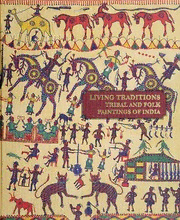
Living Traditions Tribal and Folk Paintings of India PDF
Preview Living Traditions Tribal and Folk Paintings of India
w—myr Jfmtm R. M t 4§5 vw|? r?VvSf€£2 if ngjL^i^S TL jffl ,Hg i&J #wtaaNtfa \ \ ■ s* WtWk?' gjfOF J*. trrmmimvu H1H cwjcmwmwm Figure 1.1 Madhubani painting Bihar .k wjr.w W,$h r/f/Ut'j&iagx Source: CCRTArchives, Mew Delhi 'wm2& Living Traditions Tribal and Folk Paintings of India Centre for Cultural Resources and Training Ministry of Culture, Government of India New Delhi Centre for Cultural Resources and Training Ministry of Culture, Government of India New Delhi Published 2017 by Director Centre for Cultural Resources and Training 15A, Sector 7, Dwarka, New Delhi 110075 INDIA Phone: +91 11 25309300 Fax: +91 11 25088637 Website : http://www.ccrtindia.gov.in Email: [email protected] © 2017 CENTRE FOR CULTURAL RESOURCES AND TRAINING Front Cover: Pithora Painting (detail) by Rathwas of Gujarat Artist unknown Design, processed and printed at Archana Advertising Pvt. Ltd. www.archanapress.com All Rights Reserved No part of this publication may be reproduced, stored in a retrieval system, or transmitted in any form or by any means, electronic, mechanical, photocopying, recording or otherwise, without the prior written permission of the Director, CCRT. Photo Credits Most of the photographs used in this publication arefrom CCRT Archives. We also thank National Museum, New Delhi; National Handicrafts & Handlooms Museum (Crafts Museum), New Delhi; North fone Cultural Centre (NfCC), Patiala; South Central fone Cultural Centre (SCfCC), Nagpur; Craft Revival Trust, New Delhi and Sanskriti Museum, New Delhi for lending valuable resources. Contents Acknowledgement 05 Foreword 07 Introduction 09 Pithora Painting 17 Gond Painting 21 Warli Painting 27 Saura Pictograph 33 Santhal Painting 37 Cherial Scroll Painting 43 Ganjifa (Handpainted Playing Cards) 47 Madhubani Painting 51 Alata ni pachedi 57 Sanjhi 61 Chitrakathi Painting 67 Patachitra of Odisha 73 Kaavad Mobile Shrine 7 9 Phad Painting 83 Patua Scroll Painting 89 Kalighat Painting 95 Kalamkari 101 Pichhvai 105 Bibliography 111 List of Artists 113 Acknowledgement Millions of practising artists in our country form a huge and important resource of traditional knowledge and indigenous technologies. Respect for the artist and for his/her inherent creative skills is the integral aim of this publication. The CCRT dedicates this publication to the creativity of the unnumbered, anonymous artists of our land. India is a mosaic of immense diversity encompassing a wide variety of cultural communities. People belonging to different social groups and different regions have expressed their beliefs and aspirations in a straight forward and simplistic manner through a rich and variegated repository of paintings. The influence of local history, geographic conditions, flora, fauna, cultural moorings and rituals is discernible in their work. Almost every state and agricultural and tribal community of India has its distinct painting style, and some have more than one. Differences occur even as one goes from one village to another. Their deep connection with their surroundings and their spiritual association with all manifestations of nature has shaped their work. The myths and legends associated with these paintings establish the identity of the tribe. All these features point towards the rich and varied traditions in our country. In this book we look at few of these living traditions to encourage the reader to explore and discover any similar living traditions that exist in his/her village, city or neighbourhood. The CCRT has used information provided in the records available with government institutions and other authentic sources to make this publication as informative as possible. Numerous people and organisations have helped in the production of this publication and CCRT would like to express gratitude to all of them. Exploring living traditions and its various facets was a challenging task and valuable inputs and guidance provided by Shri Mushtak Khan served as a beacon for CCRT. Our sincere thanks to Smt. Ira Pande, an eminent writer and editor associated with renowned publishers, for help in editing. Any amendment /addition to the content of this publication is most welcome from our readers. By bringing alive the everyday life of past centuries and communities these paintings also help us in understanding our origins. This publication is intended to instil artistic consciousness in the minds of the people and help them understand the aesthetic vision of the folk and tribal forms. These artistic expressions, not bound by any guidelines, emanate a tremendous vitality, spontaneity and freedom of expression-reflecting the collective consciousness of the people. With the spread of globalization and “shrinking of the world”, we are losing sight of traditional way of life and much of the beauty and creativity that accompanied it. May I end this with the dictum of Ruskin that “industry without art is brutality G.C. Joshi Director, CCRT Tribal and Folk Paintings of lndi Figure 1.4 Shura Painting, Odisha, Source: CCR'T Archives, New Delhi Figure 1.6 Gond Painting, Madhya Pradesh, Source: CCRTArchives. New Delhi (> friba] and Fo]k Paintings of India
